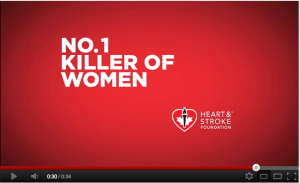February 13th, 2012
Heart and Stroke Foundation’s “Make Death Wait” Campaign: Advocacy or Scare Tactics?
Marilyn Mann, J.D.
Editor’s Note: This post is reprinted with permission from Marilyn Mann’s Blog.
I am interested to know what readers think of the two Heart and Stroke Foundation of Canada (HSF) ads shown below. The ads are part of HSF’s “Make Death Wait” awareness and fundraising campaign that’s been underway for the past few months.
In the first ad, shown in this YouTube video, several different women are shown on screen as a male voice, meant to personify death, intones “I love women. I love older women, professional women, stay-at-home moms. I love how women put their family first. I love how you’re so concerned that I’ll get to your husband.”
In the final scene, a woman in a bathing suit looks apprehensively over her shoulder as the voice warns, “You have no idea that I’m coming after you.” Eileen Melnick McCarthy, director of communications for the foundation, told a reporter that the intent of the campaign is to “wake up Canadians to the threat of heart disease and stroke.”
In addition, the print ad below has appeared in a Canadian magazine. The copy, in case you can’t make it out, reads as follows:
Death loves menopause. He loves that menopause makes women more vulnerable to heart disease and stroke. And that women are far more likely to die of a heart attack. Most of all, he loves that heart disease and stroke is the #1 killer of women. Please donate, and make death wait.
Is this a legitimate way to “wake up” people to the threat of cardiovascular disease? Or unnecessary and counterproductive scare tactics? I lean toward the latter.



The first flaw in the ad is death is a man rather than a non gender enemy. The second flaw is that it asks for money as the only solution to preventing death from getting to women. Nothing is mentioned of the factors that lead to vascular disease and what can be done to avoid or modify these factors. If this ad were to be used in the USA, death would hire a lawyer claiming that it’s first amendment rights are being violated, similar to what the tobacco companies are doing with the new cigarette FDA mandated warnings.
Competing interests pertaining specifically to this post, comment, or both:
none
In its defence, at least this is just raising awareness about the importance of heart disease to women’s health – something which I seem to recall has been studied and which tends to be underestimated by many women (compared to, say, breast cancer risk). However, it’s so one-size-fits-all; not all women are at significant cardiac risk, but this ad doesn’t tell you that. What about thinking about risk factors? Maybe I ask too much for a 30 second ad.
Odd, too, that the women death is stalking in the ad are often engaged in physical activity (jogging, swimming, dancing). I think health-oriented ads should promote physical activity, but this seems to send a mixed message.
As for the whole sleazy stalker theme, it certainly grabs attention, but rather than allowing women to feel appropriately concerned and informed, I suspect it just comes across as creepy. I will leave a proper gender studies analysis to someone else, but in a word – ew!
I belief that this add does not stimulate women to be aware and concern of the risks. This add may turn women’ attention away. Te add should focus on genetic, environmental factors and guides of how to approach it. The add should be easy to follow with good guidelines.